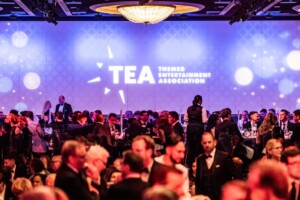Attracting and retaining the best creative talent in the entertainment and leisure industry is a challenge. Clara Rice considers Millenials, preconceptions and 3 barriers to success.

By Clara J. Rice (right), Director of Communications, JRA.
If you are a Millennial (born roughly 1981-1999), how would you describe your generation?
If you are not a Millennial, how would you describe this oft talked about group of 18 to 36-year-olds?
Usually, the adjectives look a little something like this:
While non-Millennials use descriptors like “trophy kids”, “spoiled” and “needy”, Millennials call themselves “passionate”, “inspired”, and “revolutionary”. Obviously, there is a barrier here, actually, three barriers, that are feeding these preconceptions and making creative talent attraction and retention more difficult. These barriers are Stereotype Barriers, Access Barriers, and Process Barriers.
1. Stereotype Barriers
Why should we care about stereotype barriers? In fact, why should we care about Millennials at all? Here’s why. Millennials have surpassed Baby Boomers as the largest living generation in the United States. By 2025, Millennials will occupy 75% of the American workforce. Simply put, if you aren’t willing to see past the stereotypes, you are going to have a hard time finding the best creative talent to work for you.
Breaking down the stereotype barrier involves three different but interrelated strategies:
Barrier Buster 1: Act Like You’ve Been There Before (Because You Have)
“Privileged”, “narcissistic”, “entitled”, “lazy”. While these are common terms to describe Millennials now, they were also used in a Life Magazine 1968 “Generation Gap” cover story to describe Baby Boomers. Jump 22 years to 1990, and Time Magazine was calling Gen X-ers “lazy, entitled, selfish, shallow, unambitious shoe gazers.” So is it really any surprise that 23 years after that, Time would again call 20-somethings “narcissistic, materialistic, and technology addicted?”
Stereotypes are convenient scapegoats
Instead of going into automatic judge mode, think about the stereotypes you may have had to face in interviews, or on your first day on the job. Think about how you may have perhaps deserved them with “generationally stereotypical” behaviour. I’m sure you all have some embarrassing personal narratives from your younger days.
There have been times when Millennials have said something in a professional setting that made me shudder. But instead of rolling my eyes and writing them off, I usually think, “damn, so that’s how that came across when I acted that same way 20 years ago”. I use it as a teaching moment and say, “hey, I tried that similar approach and it didn’t work very well – here’s why.” And most of the time, it resonates.
Barrier Buster 2: Don’t Throw Stones in Your Glass House
It’s their problem, right? Those needy, greedy Millennials! We have a rigid hierarchy because that’s the way it’s always been! We mandate a 9-5 workday because the projects won’t complete themselves!
Wait, you’re quitting, why?
An Outflow of Creative Talent?
If you’re seeing an outflow of Millennial creative talent, chances are, it’s not just them. Stereotypes are convenient scapegoats, but sometimes they hide culture issues that, if even slightly adjusted, would probably make your workplace a better place for everyone.
Barrier Buster 3: Check Yourself Before You Wreck Yourself
Just when you thought I was going to let Millennials off the hook, it’s time for some tough love. Gen Ys, the biggest way to not be called a stereotype is not to act like one. Because nobody’s a fan of this:
I’ve asked everyone else to put themselves in your millennial [boat] shoes. Now it’s time for you to see things from their perspective. Consider the stereotypes that your employer may have faced and the obstacles they’ve overcome to get where they are. Chances are they didn’t have a fancy title or a corner office handed to them when they started.
The bottom line is, if we treat people like people instead of caricatures, and maybe engage in some healthy self-examination, we’ll go a long way to starting some meaningful dialogue and forging potentially lifelong professional relationships.
2. Access Barriers
Speaking of dialogue and relationships, too often, the relationships between universities, companies and millennials looks a little something like this (the image above). We’re all busy in our respective silos – companies are trying to make that bottom line, universities are trying to meet academic guidelines, and millennials are trying to manage an unprecedented level of student loan debt. But this insular approach obstructs opportunities for connection. By creating more ways for these groups to access each other, universities, companies and millennials can actually meet each others’ needs and goals more efficiently.
So, again, why do we care? In 2014, Bentley University completed its Prepared U Project, the largest-ever survey assessing the preparedness of Millennials for the workforce. According to the study, preparedness meant more than education and skills. It also included work ethic and personal traits.
Millennials are not making the grade
Turns out Millennials are not making the grade.
54% of corporate recruiters gave Millennials a “C” or lower when it came to preparedness, and only 9% gave them an “A”. 62% of university educators gave recent college graduates a C or lower. And 37% of Millennials gave themselves a C or lower. What this indicates is a gap that is leaving Millennials unprepared for the workforce, recruiters with unprepared applicants, and universities with the reputation of not adequately preparing their students.
But by opening channels for communication, making that communication human, and creating opportunities, these three isolated groups can work together to overcome this preparedness gap.
Barrier Buster 1: Open Channels for Communication
Universities should offer a variety of career preparedness touch points that begin the students’ first year and extend well into the alumni experience. Activities like professional networking mixers, mock interview sessions, and co-op schemes with local companies all help students learn those work ethic and personal traits that recruiters are looking for.
Working with a local chamber of commerce, business associations, or unions can facilitate finding a pool of professionals that would be willing to help. While in-person communication is always preferable, webinars or group chats are also great, cost-effective opportunities for learning and dialogue with industry pros.
Barrier Buster 2: Personalize It
But, business professionals if you are communicating with students in person, get personal. Keep it human!
If you must lecture from a stage, tell your story, including sharing your mistakes. Speechifying about how awesome you are only going to perpetuate the stereotypical Millennial belief that they can do your job from Day One. You can’t make it look easy! It was hard for you. It was a process. Share that!
Another Millennial tough love moment
Better yet, instead of lecturing to students from the university stage, host small group salons in your office. Let them see how you work, and really listen to their reaction. By keeping interactions between companies and students personal, you not only – surprise! – get to know the whole person, you give the Millennial a better sense of what they are in for should they choose to join your company.
Barrier Buster 3: Choose Create Your Own Adventure
Time for another Millennial tough love moment. Let’s return to that Bentley survey. Of the Millennials who gave themselves a “C” or lower, 60% of them said that their unpreparedness was their own fault.
Students, take advantage of the opportunities that are available to you. Meet with your career development office your first year, and set a path for the internships and training you want to receive. Attend that webinar and apply for a scholarship to that conference.
If you don’t see what you are a looking for – CREATE IT! Grab like-minded students together and start a club around your chosen field. Work with your professors to invite a speaker to campus. Ask to shadow a family friend at their office or to do a mock interview with you.
This is the perfect time to experiment. You can fail with minimal risk, all the while raising your preparedness grade and setting the course for a fantastic career.
3. Process Barriers
Now, let’s look at the actual processes of attraction and retention.
But first – we began this article with a rather unflattering look at Millennials in the workforce. Now let’s take a look at how Millennials feel about working for Baby Boomers:
Again, why care? This section is so important, I’ll offer three reasons:
Remember that Bentley study? Well here’s another interesting statistic – 35% of business leaders gave recent college graduates they themselves hired a C or lower. That means that more than a third of the time, their recruitment practices missed the mark. And that means a lot of wasted time for you and your HR department.
Attract Creative Talent, Don’t Make Bad Hires
That wasted time equates to wasted money. While the Department of Labor estimates the cost of a bad hire at about 30% of the employee’s first year earnings, online retailer Zappos estimates that bad hires have cost the company “well over $100 million!”
Why so expensive? Well, there’s the loss of productivity, the cost and lost time to recruit and train another worker, and a possible negative impact on client relations. But there’s also a ripple effect. A bad hire can affect morale and burn out your productive employees as they try to pick up the slack. All in all, it’s an expensive headache that can be avoided with some simple improvements to your talent acquisition strategy.
Assess your Company Culture
By 2020, 2/3rds of Millennials will be looking to move on. Why? Because only 28% of Millennials feel that their current employers are making full use of the skills they have to offer. Keep in mind, Millennials range in age from 18 to 36. So this exodus doesn’t just involve your entry-level employees; it could also mean an outflow of your middle managers and directors.
If you don’t re-assess your company culture now, your creative talent is going to leave you for your competitors.
So how do you break down the process barrier? To keep this fun, we’ll examine the three strategies through the lens of dating.
Barrier Buster 1: Choose Talent Acquisition Over Recruitment
Courting Creative Talent
The best way to describe recruitment versus talent acquisition is the fling versus the long-term relationship. When you’re recruiting, you’re looking at filling a short-term void, usually with the same list of attributes held by the previous individual. You post an online profile, mark your respondents against a series of checkboxes and keywords, narrow it down to a short list of candidates, send them an email, and hope they respond so you can set up a first date (in the business case, the interview). If they don’t accept your final rose, you defer to the next best match.
Talent acquisition, on the other hand, is more of the long-term relationship approach. It means looking at your succession plan or attrition history and seeing where the gaps are not just now, but where they may be in the future. It means building mutually beneficial partnerships with associations, universities, and other potential candidate communities. It’s more than checkboxes, it’s engagement in the form of meeting candidates where they are instead of just expecting them to come to you. It’s a true courtship, instead of just Tinder.
While it seems like a huge investment of time on the front end, taking a proactive stance on hiring can mean more cost savings, and less heartache.
Barrier Buster 2: Be Transparent and Honest
Many of us Gen X and Y-ers have looked at an online dating profile like this one only to find that your dream date is in reality unemployed, twenty years older and, well, let’s just say, not physically what you expected. If you want to make a relationship last, you need to a) be clear with your expectations and b) live your values.
Transparent Millenials
Millennials, if flexible work hours are non-negotiable, and the potential employer demands a 9-5 workday, then this is probably not the job for you. Companies, be clear in the offer conversation about what your office culture is like. Then, when your successful candidate arrives on Day One, make sure you are practicing what you preach. If your values are just words on a wall, then your Millennial new hire is going to feel just like the person who responded to this ad (above) only to find that their online Prince Charming was more like Prince Alarming.
The clearer a picture companies can give about how they operate, and the more transparent Millennials can be about what they expect, the greater the chances that the hire will be a successful match.
Barrier Buster 3: Inspire a Long-Term Commitment
Congratulations, you’ve found your special someone. But how can you entice Millennials into a long-term commitment? Here’s a hint – it’s not (just) free food and comfy couches.
Millennials are looking for culture fit. While compensation should be fair, Millennials generally value purpose over paycheck. They want to feel like they are part of a team working towards a common goal, that their projects are not menial tasks in and of themselves, but part of a bigger vision.
Millennials want Yoda
Millennials don’t want bosses, they want yodas. They don’t want feedback every six months or a year, they want it consistently, because in their personal lives communication is real-time. Be clear about how often they can expect feedback or guidance from you, and try to set up regular touchpoints.
Millennials are an entrepreneurial generation that values autonomy and flexibility over rigidity and hierarchy. Consider whether a forty-hour week or a business-casual dress code are really necessary as long as the work is getting done. Let them take a class they are interested in to show that you value their continued professional development. Challenge them with tasks that are low-risk and potentially high reward to give them additional experience. And, while not making any promises to them directly, offer examples on how other people in their shoes have progressed through the company.
Yes, all of the above take time and perhaps money, but they are all a lot cheaper than finding a new employee. And really, you can’t put a price on long-term love.
Bonus Barrier: Meet in the Middle
Speaking of love, here’s the last bit of Millennial tough love.
Millennial tough love
Millennials, when you enter the front door of your new company, think of it as entering your in-laws’ home right after you’ve gotten married. The company is doing their best, but not everything is going to be perfect on Day One, and it’s going to take a few months for you to really feel like a part of the family.
Have patience, think before you speak and respect the fact that you are in their home. Then, over time, when you are part of the family, you’ll be able to bring more of your personality, energy and ideas to the table, knowing that you are on the same page with your co-workers and bosses.
So, to review the success pathways for Creative Talent Attraction and Retention:
- Use stereotypes for good and not for evil.
- Create multiple channels for meaningful, personal communication among Millennials, universities and professionals.
- Leverage opportunities and partnerships.
- Aim for the long-term relationship versus the short-term rebound.
- Find common ground. Meet in the middle.

With a tech-savvy, highly-motivated generation flooding the workforce, there’s probably never been a more exciting time to attract and retain Millennial thinkers. If we broaden our perceptions, pool our resources and create welcoming work environments, we can turn the current generation of Creative Talent into the next generation of industry leaders.
Note: this article was taken from a presentation, “Breaking Barriers: How to Attract and Retain Creative Talent” originally presented at the Themed Entertainment Association’s Creative Economy SATE Academy Day.
All images kind courtesy JRA.































